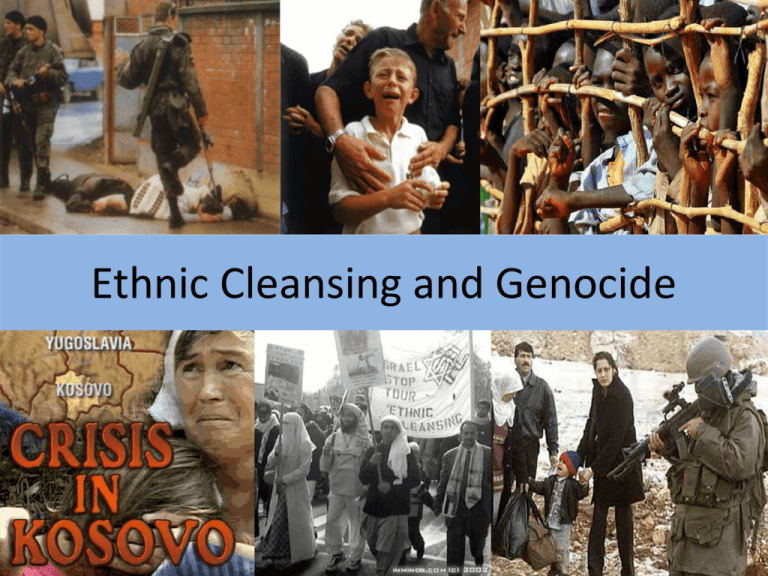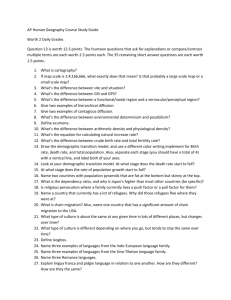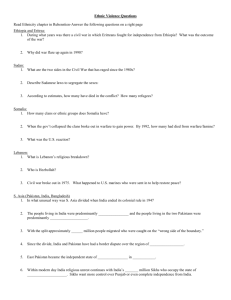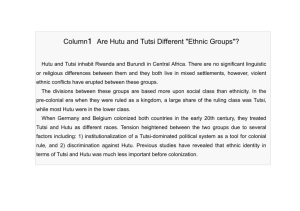(Ethnic Cleansing)
advertisement

Ethnic Cleansing and Genocide ETHNIC CLEANSING Ethnic Cleansing is the process by which a more powerful ethnic group forcibly removes (and often exterminates) a less powerful one in order to create an ethnically homogenous region. Ethnic cleansing is not merely a war targeting male soldiers. Instead it aims of removing every single member of an ethnic group (mean, women, children, the elderly). The aim is for the dominant ethnic group to be the SOLE inhabitants of an area. Recently, ethnic cleansing has occurred primarily in Europe and Africa. ETHNIC CLEANSING IN EUROPE Historically the largest process of ethnic cleansing in Europe came at the hands of Nazi Germany. They deported and otherwise exterminated millions of Jews, Roma, Sinti, Africanyears, and other ethnic In recent ethnic minorities. cleansing has centered in parts of the Yugoslavia After theformer war, millions of Poles, on Germans, Russians and other ethnic the Balkan Peninsula. groups were also forced to migrate from regions as national boundaries The Balkan Peninsula includes were redrawn. Greece, Bulgaria, Romania and the various countries of the former Yugoslavia. ETHNIC CLEANSING IN EUROPE CREATION OF YUGOSLAVIA The Balkan Peninsula has long been a hotbed of ethnic clashes. Austria-Hungary ruled the north, the Ottoman Empire ruled the south. In 1878, Austria-Hungary seized Bosnia-Herzegovina. In 1914, a Bosnian Serb seeking Bosnian independence assassinated the heir to the throne of Austria-Hungary and sparked WWI. After WWI, the allies created Yugo(south)-slavia as a multiethnic state to unite several slavic speaking Balkan ethnic groups. Yugoslavia was held together by Josip Broz Tito from 1953 to 1980 and was comprised of six republics: Bosnia & Herzegovina (mix of Serbs, Croats and Muslims) Croatia (for the Croat nationality) Macedonia (for the Macedonian nationality) Montenegro (for the Montenegran nationality) Serbia (for the Serb nationality) Slovenia (for the Slovene nationality) There were four official languages: Croatian, Macedonian, Serbian, and Slovene And three major religions: Catholic in the north, Orthodox in the east and Muslim in the south. ETHNIC CLEANSING IN EUROPE DESTRUCTION OF YUGOSLAVIA After Tito’s death in 1980, ethnic violence erupted and the various republics began to break away. In the 1990s, Bosnia & Herzegovina, Croatia, Macedonia and Slovenia broke away and then Montenegro in 2006 leaving Slovenia standing on its own. Ethnic groups were relatively peaceful as republics within Yugoslavia, but when the republics were transformed into separate countries, clashes erupted over the placement of borders. The boundaries failed to match the ethnic territories and several other smaller but important ethnic groups failed to get recognition as nationalities. ETHNIC CLEANSING IN EUROPE CLEANSING IN BOSNIA Bosnia consisted of 48% Bosnian Muslims, 37% Serbs and 14% Croatian. However, the Bosnian Muslims were considered an ethnicity rather than a separate nationality. Bosnian Serbs and Bosnian Croats did not want to live in a multiethnic state with a Muslim majority, and so they fought to unite their respective regions with Serbia and Croatia. To strengthen their case, both Bosnian Serbs and Bosnian Croats sought to cleanse their regions and create homogenous regions. The Dayton Accords in 1996 created three regions, each dominated by a separate ethnicity. The Bosnian Croat and Muslim regions were united into a federation with some cooperation. The Serb region has operated in almost complete isolation. The success of their cleansing campaign won them almost half of the country even thought they represented only 1/3 of the population. Croats (1/6 of population) got ¼ of the land. Bosnian Muslims (1/2 of population) got ¼ of the land. ETHNIC CLEANSING IN EUROPE BALKINIZATION The term balkanized refers to an area that cannot be successfully organized into one or more stable/successful states because it is inhabited by a number of ethnicities with a long-standing hatred and mistrust of one another. Balkanization is the process by which a state fails and breaks apart due to conflicts among its ethnicities. The Balkans themselves have once again become balkanized, and the Balkan Peninsula, like the Caucasus region is considered a shatterbelt. ETHNIC CLEANSING IN EUROPE CLEANSING IN KOSOVO Serbia remained a multiethnic state after the fall of Yugoslavia. Albanians represented 90% of the population in Serbia’s Kosovo region. Serbia was given control of Kosovo when Yugoslavia was formed, but under Tito, ethnic Albanians in Kosovo got administrative autonomy and national identity. When Yugoslavia dissolved, Serbians began an ethnic cleansing campaign of Albanians in Kosovo. Over 750,000 of the region’s 2 million Albanians were forced from their homes (fleeing mostly to Albania). NATO forces launched an air attack against Serbian forces, and in 2008, Kosovo declared its independence from Serbia. ETHNIC CLEANSING IN AFRICA In the 19th and 20th centuries, European countries carved Africa into various colonies with no regard for ethnic boundaries. Modern ethnic clashes in Africa result largely from state boundaries of former colonies not at all matching ethnic boundaries. African identity has always formed along ethnic (tribal) boundaries, with each tribe having its own tradition of religion, language and custom. It is difficult to determine the exact number of tribes due to indistinct geographic and ethnic boundaries. New states formed after colonial powers left typically followed the colonial boundary lines. Therefore, some tribes were divided between numerous states, ad other tribes found themselves grouped in a state with dissimilar tribes. ETHNIC CLEANSING IN AFRICA ETHNIC CLEANSING IN RWANDA The Hutu were the indigenous population of Rwanda and were farmers. The Tutsi were rift valley herders who migrated into Rwanda 400 years ago. Although only 15% of the population, the Tutsi took control of the region and made the Hutu into serfs. In 1899, Rwanda, and Burundi to the south, became a German colony, and after WWI, the colony was given to Belgium. Belgium classified the population into racial categories, and even though the tribes were largely indistinguishable randomly assigned identity cards making some Tutsi and others Hutu. The Tutsi were classified as white and were allowed to attend college and given administrative government positions. The Hutu were classified as black, were kept uneducated and given only labor positions. Rwanda gained independence in 1962, the Hutu were allowed to voted, and as the majority gained control of the country. Reprisals and ethnic cleansing campaigns began at that point and culminated in 1994 with a genocide of nearly 1 million Tutsi in under a year. Tutsi later counterattacked for control, causing 2 million Hutu to flee Rwanda, and in Burundi displaced Hutu and Tutsi both attacked each other. Refugees have since returned to both countries and democratic elections have been held in both. ETHNIC CLEANSING IN AFRICA ETHNIC CLEANSING IN THE DRC The Hutu / Tutsi conflict spilled over into the Democratic Republic of Congo, the country to the immediate west of Rwanda and Burundi. As of 2009, over 5.4 million people had died in civil wars raging in the DRC. In 1997 Tutsi armies from Rwanda invaded the DRC to flush out Hutu militias. While there, Tutsi armies helped rebels overthrow president Mobuto and install new president Laurent Kabila. Kabila allowed Tutsi armies to kill various populations of Hutu in reprisal for the 1994 genocide in Rwanda. In 2001 Tutsi helped Congolese rebels assassinate Kabila an install his son. Fighting continues in the DRC, especially along the eastern border.







